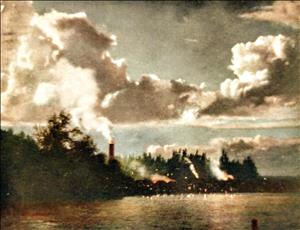At 12:40 p.m. on January 17, 1993, demolition experts collapse the landmark American Smelter and Refining Company (ASARCO) smokestack as part of a Superfund toxic cleanup of the old copper smelter in Ruston. As many as 100,000 people gather to witness the detonation that, with one push of a plunger, sets off charges that in eight seconds reduces the structure to rubble and dust.
A Key Tacoma Firm
The ASARCO plant site had nearly 100 years of history, beginning as the Ryan Smelter, a lead-refining company built by investor Dennis Ryan in 1888. Two years later it became the Tacoma Smelting and Refining Company, under the ownership of William Rust (1850-1928) who began modernizing and expanding the facility. Rust sold the plant for $5.5 million in 1905 to the American Smelter and Refining Company (ASARCO), which converted the plant for copper smelting and refining in 1912.
In the 1920s the Port of Tacoma granted a 30-year lease of harbor land to the American Smelters Securities Company to allow for an extensive plant expansion. ASARCO operated the smelter at the Ruston site until its closure in 1985 due to weak copper markets and a need for pollution control. It had been one of Pierce County’s largest employers.
From Gem to Polluter
The smokestack dated to 1917. Considered at the time an engineering gem, it was constructed of 2.5 million bricks, approximately 5,000 tons of mortar and stood 571 feet tall, making it then the largest smokestack in the world. Earthquake damage in 1937 necessitated repairs and the stack was reduced to 562 feet in height. Once a sign of prosperity, the stack had over the years become a symbol of environmental pollution. Structurally it had become unsafe; many of its bricks were loose and in danger of falling. The smokestack had even attracted daredevils, from local youths to Greenpeace protestors.
The 67-acre ASARCO smelter site was listed as one of the country’s most polluted sites, primary contaminants being arsenic and lead. The Environmental Protection Agency (EPA) called for an eight-stage cleanup that included demolishing structures, excavating soil and slag from the most contaminated locations, disposing of the contaminates, plugging or removing surface water drainage, capping the project area, protecting the site from erosion, continuing monitoring impacts on groundwater and marine sediments and integrating cleanup with future land use plans.
A Festive Occasion
Some who came to witness the smokestack’s demolition had been plant employees or knew people who had worked there and expressed nostalgia at the event. But mostly, as the newspapers reported, it was a well photographed and festive occasion. Local stores even sold sweatshirts commemorating the event. Souvenir hunters hoped to collect bricks after the demolition but, for fear of arsenic and lead contamination, the bricks were swept into a previously prepared 360-foot ditch.
Only days after the smokestack’s demise, ASARCO faced fines from the EPA for being late with a draft plan for future site cleanup. Legal hassles continued and the site eventually accommodated waste from the old ASARCO smelter in Everett. On May 25, 2004 work crews began demolishing the old ASARCO Fine Ores Bins Building, the last remaining landmark of the company’s copper smelter in Ruston and thus making way for new development. A billion-dollar condominium project called Point Ruston will add residential units in the $300,000 price range. Construction of the first building commenced in May 2008.

